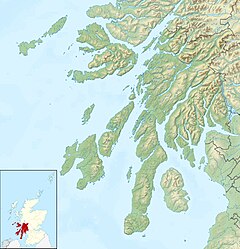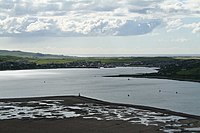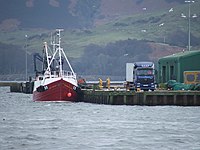Campbeltown
 From Wikipedia - Reading time: 18 min
From Wikipedia - Reading time: 18 min
Campbeltown
| |
|---|---|
| Town and former royal burgh | |
 Campbeltown Viewed from the slopes of Beinn Ghuilean | |
Location within Argyll and Bute | |
| Population | 4,500 (2022)[3] |
| OS grid reference | NR 71800 20300 |
| • Edinburgh | 101 mi (163 km) |
| • London | 352 mi (566 km) |
| Council area |
|
| Lieutenancy area |
|
| Country | Scotland |
| Sovereign state | United Kingdom |
| Post town | Campbeltown |
| Postcode district | PA28 |
| Dialling code | 01586 |
| UK Parliament | |
| Scottish Parliament | |
Campbeltown (/ˈkæmbəltən/ ⓘ; Scottish Gaelic: Ceann Loch Chille Chiarain or Ceann Locha) is a town and former royal burgh in Argyll and Bute, Scotland. It lies by Campbeltown Loch on the Kintyre Peninsula. Campbeltown became an important centre for Scotch whisky, and a busy fishing port.
The 2018 population estimate was 4,600 indicating a reduction since the 2011 census.[4]
History
[edit]Originally known as Kinlochkilkerran (an anglicization of the Gaelic, which means 'head of the loch by the kirk of Ciarán'), Campbeltown was renamed in the 17th century as Campbell's Town after Archibald Campbell (Earl of Argyll) was granted the site in 1667.[5] Campbeltown Town Hall was completed in 1760.[6]
The Royal National Lifeboat Institution opened Campbeltown Lifeboat Station in 1861. The present building dates from 1996.[7]
Economy
[edit]
In addition to the benefits of distilling, and whisky tourism, there were two major employers in 2018, Campbeltown Creamery and CS Wind UK, who provided "a substantial portion of the Campbeltown area’s high skilled jobs and are a vital part of the local economy," according to the Scottish government. A report in October 2019 had raised warning signs for the economy of Argyll & Bute; the report also suggested that up to 70 jobs at CS Wind UK could be lost but did not specify a time frame.[8]
Both companies confirmed the prediction of job redundancies, leading the Scottish government to hold an emergency summit in November 2019 to discuss steps that might be taken for improving the local economy. Participants included Argyll & Bute Council, Highlands & Islands Enterprise, trades unions and local employers.[9][10] After the summit, a "working group" was formed in late November 2019.[11]
The number of dairy farms supplying Campbeltown Creamery reduced from 147 to 28 and the number of dairy cows fell from 6600 to 2500. Consequently, the Creamery became unviable. A plan by a small number of local dairy farmers to take over the running of the Creamery failed in early December 2019. The milk produced in Kintyre is now transported by road tankers to Lockerbie and Mull of Kintyre Cheddar is no longer available.[10]
By early December 2019, CS Wind UK had declared 22 jobs redundant. The Scottish government was working with the company to search for long-term solutions.[12] Preliminary discussions did not produce optimism about the future stability of the company. The Unite union indicated that while CS Wind had been profitable, it was not receiving an adequate number of orders to sustain full employment.[13] The plant was shut down in 2019 and production shifted to CS Wind's cheaper Vietnam plant in Phú Mỹ.[14]
Whisky
[edit]Campbeltown is one of five areas in Scotland categorised as a distinct malt whisky producing region, and is home to the Campbeltown single malts. At one point it had over 30 distilleries and proclaimed itself "the whisky capital of the world". However, a focus on quantity rather than quality, and the combination of Prohibition and the Great Depression in the United States, led to most distilleries going out of business. Today only three active distilleries remain in Campbeltown: Glen Scotia, Glengyle, and Springbank.[15][16][17][18]
Campbeltown is a "protected locality" for Scotch Whisky distilling under the UK's Scotch Whisky Regulations 2009.[19]
The folk song titled "Campbeltown Loch, I wish you were whisky" is based on the town's history in this industry.[20]
Climate
[edit]As with the rest of Scotland, Campbeltown experiences a maritime climate with cool summers and mild winters. The nearest official Met Office weather station for which online records are available is at Campbeltown Airport/RAF Machrihanish, about 3 mi (4.8 km) west of the town centre.
The lowest temperature to be reported in recent years was −12.9 °C (8.8 °F) during December 2010.[21]
| Climate data for Campbeltown Airport, 10 m (33 ft) ASL, 1991–2020 | |||||||||||||
|---|---|---|---|---|---|---|---|---|---|---|---|---|---|
| Month | Jan | Feb | Mar | Apr | May | Jun | Jul | Aug | Sep | Oct | Nov | Dec | Year |
| Mean daily maximum °C (°F) | 8.0 (46.4) |
8.2 (46.8) |
9.5 (49.1) |
11.5 (52.7) |
14.2 (57.6) |
16.2 (61.2) |
17.6 (63.7) |
17.7 (63.9) |
16.2 (61.2) |
13.3 (55.9) |
10.4 (50.7) |
8.6 (47.5) |
12.6 (54.7) |
| Mean daily minimum °C (°F) | 2.9 (37.2) |
2.7 (36.9) |
3.4 (38.1) |
4.7 (40.5) |
6.9 (44.4) |
9.6 (49.3) |
11.3 (52.3) |
11.4 (52.5) |
10.1 (50.2) |
7.6 (45.7) |
5.1 (41.2) |
3.1 (37.6) |
6.6 (43.9) |
| Average rainfall mm (inches) | 130.3 (5.13) |
104.4 (4.11) |
91.2 (3.59) |
71.1 (2.80) |
69.2 (2.72) |
71.4 (2.81) |
86.5 (3.41) |
99.0 (3.90) |
94.1 (3.70) |
136.2 (5.36) |
140.6 (5.54) |
135.4 (5.33) |
1,229.3 (48.40) |
| Average rainy days (≥ 0.1 mm) | 18.8 | 15.7 | 14.7 | 12.4 | 12.6 | 12.0 | 14.0 | 14.8 | 14.9 | 17.3 | 18.8 | 18.0 | 184.0 |
| Mean monthly sunshine hours | 46.9 | 78.3 | 108.4 | 170.3 | 216.4 | 180.6 | 160.1 | 162.5 | 130.7 | 89.7 | 54.9 | 42.3 | 1,441.2 |
| Source: Met Office[22] | |||||||||||||
Culture
[edit]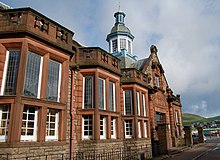

Campbeltown boasts a museum and a heritage centre. The museum has a varied collection of items from Campbeltown's past, and prehistoric items excavated from sites around Kintyre, such as axeheads, jewellery and combs. The 19th-century building, by John James Burnet, also houses the Registrars office and Customer Service Point for Argyll and Bute council and has plaques or exhibits related to famous Kintyre people: for example, William McTaggart and William Mackinnon.[23] Near the museum is the cinema known as the Wee Picture House, a small but distinctive Art Nouveau building of the Glasgow School dating from 1913 and believed to be the oldest surviving purpose-built cinema in Scotland.[24] These buildings are on the waterfront, as is a 14th-century Celtic cross that also served as a mercat cross.[25][26]
St Kieran (Ciarán of Clonmacnoise) lived in this area before the town existed.[27] A cave named after him can be visited at low tide, as can the cave on nearby Island Davaar where pilgrims and tourists go to see a 19th-century crucifixion painting.[28]
Campbeltown also hosts the annual Mull Of Kintyre Music Festival, which has seen acts ranging from up-and-coming local bands to well-established groups such as Deacon Blue, The Stranglers and Idlewild perform.[29]
The Kintyre Songwriters Festival, a fairly low key annual gathering aimed at promoting the wealth and variety of original music across the area, which started in 2009. The festival is held during the last weekend of May and is open to anyone interested in performing.[30]
On Friday 16 June 2006, First Minister Jack McConnell flew to Campbeltown to officially open Campbeltown's new 'Aqualibrium' Centre. Aqualibrium, designed by Page\Park Architects, replaced the old Campbeltown swimming pool, which was previously closed due to safety concerns; the centre houses Campbeltown's library (with the old building being the museum only), swimming pool, gym, conference centre and 'Mussel Ebb' Cafe.[31]
The Kintyre Camanachd are a local shinty team that belongs to the Camanachd Association.[32]
The local amateur football team, Campbeltown Pupils AFC, are members of the West of Scotland Football League Division 4 which largely comprises clubs based in the Greater Glasgow and Inverclyde areas, requiring the Campbeltown team to make a round trip of over 200 miles (320 km) for away fixtures most weekends.[33]
Argyll FM is a local radio station based in Campbeltown on 106.5, 107.1 and 107.7.[34]
In May 2012 Campbeltown and Dunoon were jointly named in a report by the Scottish Agricultural College as the rural places in Scotland most vulnerable to a downturn. The "vulnerability index" ranked 90 Scottish locations according to factors associated with economic and social change.[35][36]
Politics
[edit]Campbeltown is part of the Argyll, Bute and South Lochaber constituency for elections to the House of Commons of the United Kingdom.[37]
Infrastructure
[edit]Telecommunications
[edit]The West Highland Telegraph was extended to Campbeltown in 1865 when the Universal Private Telegraph Company opened a telegraph office.[38]
The first telephone exchange was opened by the National Telephone Company in the early 1900s. It was modernised in 1939 with the introduction of direct dialling[39] and went digital in 1991 following the upgrade of the Lochgilphead exchange.[40]
Electricity
[edit]
Electricity for domestic consumption arrived on 17 October 1935 when the Campbeltown and Mid Argyll Electric Power Company’s new power station in Glebe Street was inaugurated.[41] The power station was built in the former premises of the Co-operative Society’s laundry. Two 150 h.p. oil fired engines drove the generators built by Ruston and Honsby.[42] The street lighting in the town was converted from gas to electricity in 1936.[43]
Transport
[edit]

Campbeltown Airport is near the town, and has a scheduled service to/from Glasgow International Airport on weekdays and some summer Sundays.[44]
The town is the westernmost town in the island of Great Britain (if the port of Mallaig is not counted as a town). It has the population of a large village, but lays claim to its town status based on its port and its central close grid of streets. Its position near the end of a long peninsula makes for a time-consuming road journey, and to some extent the area relies on sea and air transport, like the Inner Hebrides. However it is linked to the rest of Scotland by the A83 (to Tarbet) and A82 (from Tarbet to Glasgow). Bus service is provided by West Coast Motors, who also operate services to Glasgow for Scottish Citylink.[45]
Ferries sail from Campbeltown to Ballycastle in Northern Ireland, operated by Kintyre Express. The service, which runs to Ballycastle every Friday to Monday during summer months and on Mondays and Fridays during the winter months, commenced in 2011.[46]
In 2006 a foot passenger ferry operated by Kintyre Express ran between Campbeltown and Troon every Monday, Wednesday and Friday with a crossing time of one hour in calm weather. By 2007 this ferry no longer ran, although the vessel can be chartered privately.[46]
Starting 23 May 2013, Caledonian MacBrayne began operating a ferry service across the Firth of Clyde to Ardrossan, calling at Brodick on Saturdays.[47]
Campbeltown was linked to Machrihanish by a canal (1794 – mid-1880s) that was superseded by the Campbeltown and Machrihanish Light Railway, which closed in 1932. The railway, which was originally built to serve the Machrihanish Coalfield, ran from Campbeltown railway station to Machrihanish railway station.[48]
| Preceding station | Ferry | Following station | ||
|---|---|---|---|---|
| Terminus | Caledonian MacBrayne Kintyre Ferry (Suspended for the summer 2025 season)[49] |
Ardrossan | ||
| Brodick | ||||
| Terminus | Kintyre Express Ferry |
Ballycastle |
Language
[edit]Campbeltown is one of the few communities in the Scottish Highlands where the Scots language predominated in recent centuries, rather than the previously widespread Scottish Gaelic, an enclave of Lowland Scots speech surrounded by Highland Scottish speech.[50]
Notable people
[edit]
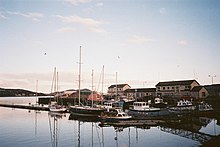
- Alexander Beith, minister and author in Gaelic and English. Free Church Moderator[51]
- Hugh Henry Brackenridge, American writer, lawyer, judge, and justice of the Pennsylvania Supreme Court[52]
- John Campbell Mitchell, landscape artist[53]
- T. Lindsay Galloway, civil and mining engineer and coal master of Argyll Colliery[54]
- James Gulliver, founder of Argyll Foods[55]
- Sir William Mackinnon, 1st Baronet, Scottish ship-owner and businessman[56]
- Norman Macleod (Caraid nan Gaidheal), Scottish divine and miscellaneous writer, served at the parish of Campbeltown, father of Norman Macleod (below)[57]
- Norman Macleod, Scottish clergyman and author[58]
- Angus MacVicar, author and broadcaster[59]
- Neil McBain, professional footballer and football manager[60]
- Paul McCartney, musician, singer, songwriter, ex-member of the Beatles and an ex-leader of Wings, owns a farm (named High Park) near the town[61]
- Jill McGown, British writer of mystery novels[62]
- Duncan McNab McEachran, Canadian veterinarian and academic[63]
- Dan McPhail, professional footballer who made 437 appearances in the Football League[64]
- William McTaggart, landscape artist[65]
- Denzil Meyrick, author of Kinloch novels[66]
- John Neil Munro, journalist and author of biographies[67]
- Rodney Pattisson, English yachtsman[68]
- George Pirie, artist who was associated with the Glasgow Boys in the 1880s[69]
- Kieran Prendergast, diplomat and a former Under-Secretary-General for Political Affairs at the United Nations[70]
- Bob Pursell, footballer who played for Liverpool F.C. in the early 20th century[71]
- Peter Pursell, footballer. he won one cap for Scotland in 1914[72]
- Very Rev James Curdie Russell, Moderator of the General Assembly of the Church of Scotland[73] minister of Campbeltown[74]
- David Smith (Rhodesian politician), Deputy Prime Minister of Rhodesia
- Angus Stewart, Lord Stewart, lawyer and Senator of the College of Justice, a judge of the Supreme Courts of Scotland[75]
- John Stewart, Australian politician[76]
- Gerald Tait, Olympic sailor[77]
- Lawrence Tynes, placekicker in the National Football League. Grew up in Campbeltown when his father was with the US Navy[78]
- George Wylie, member of the Wisconsin State Assembly and State Senate[79]
Town twinnings
[edit]Campbeltown is twinned with Kümmersbruck, Bavaria, Germany. [80]
Gallery
[edit]See also
[edit]- Lochend Castle, Campbeltown
- Charles Campbell (member for Campbeltown)
- Hazelburn distillery
- HMS Minona
References
[edit]- ^ "Ainmean-Àite na h-Alba - Gaelic Place-Names of Scotland - Database". Archived from the original on 12 April 2022. Retrieved 28 August 2018.
- ^ "Scotslanguage.com - Names in Scots - Places in Scotland".
- ^ "Mid-2020 Population Estimates for Settlements and Localities in Scotland". National Records of Scotland. 31 March 2022. Retrieved 31 March 2022.
- ^ "Campbeltown (Argyll and Bute, Scotland, United Kingdom) - Population Statistics, Charts, Map, Location, Weather and Web Information". www.citypopulation.de.
- ^ "Campbeltown" in A Dictionary of British Place-Names, A. D. Mills, Oxford University Press, 2003. Oxford Reference Online. Oxford University Press. University of Hull. 12 December 2009
- ^ Historic Environment Scotland. "Main Street, Town Hall, including lamp standards (LB22918)". Retrieved 9 July 2022.
- ^ "Portpatrick's station history". RNLI. Retrieved 5 August 2024.
- ^ "Largely negative economic data and a slew of job losses, the North Coast 500 shows which economic road to take – The State of Britain".
- ^ "Campbeltown economic summit - gov.scot". www.gov.scot.
- ^ a b Cameron, Greig (17 May 2023). "Farmers join forces in attempt to save Campbeltown Creamery" – via www.thetimes.co.uk.
- ^ "Working group formed after emergency economic summit". Campbeltown Courier. 22 November 2019.
- ^ "First Minister intervention plea as jobs go at CS Wind". Scotland Against Spin. 5 December 2019.
- ^ McPhee, David (3 December 2019). "Scottish Government sought to 'assist' troubled CS Wind prior to job losses". Energy Voice.
- ^ Meek, James (15 July 2021). "Who holds the welding rod?". London Review of Books. 43 (14). Retrieved 10 July 2021.
- ^ "The World of Scotch Whisky" (PDF). Archived from the original (PDF) on 9 January 2014.
- ^ "The five single malt scotch whisky whiskey regions explained. scotland wisky higlands speyside campbeltown islay lowlands". 24 September 2009. Archived from the original on 24 September 2009.
- ^ D8. "Scotch Whisky Association - Whisky Regions & Tours". Archived from the original on 9 January 2014. Retrieved 9 January 2014.
{{cite web}}: CS1 maint: numeric names: authors list (link) - ^ Stirk, David (1 January 2005). The Distilleries of Campbeltown: The Rise and Fall of the Whisky Capital of the World. Angels' Share. ISBN 9781903238844 – via Google Books.
- ^ "The Scotch Whisky Regulations 2009". www.legislation.gov.uk.
- ^ Stewart, Andy (2010). ""Campbeltown Loch, (I wish you were whisky)"". Spotify. Retrieved 10 July 2022.
- ^ "2010 minimum". UKMO. 24 December 2010.
- ^ "Machrihanish". Met Office. Retrieved 16 June 2024.
- ^ Historic Environment Scotland. "St John Street and Hall Street, Public Library and Museum, with Librarian's House, Garden, Railings, Gates, and Gatepiers (Category A Listed Building) (LB22964)". Retrieved 2 April 2019.
- ^ Historic Environment Scotland. "Hall Street, The Picture House (Category A Listed Building) (LB22965)". Retrieved 2 April 2019.
- ^ "Campbeltown Cross". Kintyremag.co.uk. 28 December 1950. Archived from the original on 21 August 2008. Retrieved 21 August 2009.
- ^ "Campbeltown Cross, Hall Street".
- ^ "TravelDock". Archived from the original on 9 January 2014.
- ^ "Che vandal attacks Christ image". BBC News. 1 August 2006. Retrieved 11 December 2007.
- ^ "Mull of Kintyre Music Festival". Mokfest.com. Retrieved 21 August 2009.
- ^ "Call for local musicians to take part in 2022 Kintyre Songwriters Festival". Campbeltown Courier. 16 March 2022.
- ^ "£7m Aqualibrium planned for Campbeltown". Health Club Management. 27 February 2006. Retrieved 16 March 2022.
- ^ "Shinty in South Kintyre". Archived from the original on 23 April 2011. Retrieved 13 April 2011.
- ^ Join Campbeltown Pupils AFC as they make a 260 mile trip just for a game of football, A View from the Terrace (BBC Scotland), 28 February 2020
- ^ "Argyll FM". Tune In. Retrieved 16 March 2022.
- ^ "BBC News - 'Vulnerable' Scottish rural towns listed". Bbc.co.uk. 28 May 2012. Retrieved 28 May 2012.
- ^ "Revealed: our rural towns on the brink". The Scotsman. 12 May 2012. Retrieved 9 June 2014.
- ^ "Argyll, Bute and South Lochaber - General election results 2024". BBC News. Retrieved 27 December 2024.
- ^ "The Telegraph". Glasgow Herald. Scotland. 5 September 1865. Retrieved 12 September 2024 – via British Newspaper Archive.
- ^ "Now Automatic". Daily Record. Scotland. 8 June 1939. Retrieved 12 September 2024 – via British Newspaper Archive.
- ^ "Campbeltown Exchange goes digital". Campbeltown Courier. Scotland. 6 December 1991. Retrieved 12 September 2024 – via British Newspaper Archive.
- ^ "Electricity supply for Campbeltown". The Scotsman. Scotland. 25 October 1935. Retrieved 12 September 2024 – via British Newspaper Archive.
- ^ "Campbeltown makes history unknown to general public". Campbeltown Courier. Scotland. 25 October 1935. Retrieved 12 September 2024 – via British Newspaper Archive.
- ^ "Conversion of Street Lighting". Compbeltown Courier. England. 5 September 1936. Retrieved 22 September 2024 – via British Newspaper Archive.
- ^ "Flybe timetable: flight from Campbelltown Airport". Flybe. Retrieved 11 October 2014.
- ^ "Services". West Coast Motors. Retrieved 10 July 2022.
- ^ a b Plan B - The Creative Edge. "Kintyre Express". Kintyre Express. Retrieved 21 August 2009.
- ^ "New ferry link for Campbeltown". Caledonian MacBrayne. 15 April 2013. Retrieved 9 June 2014.
- ^ Macmillan, Nigel S.C. (2000). The Campbeltown & Machrihanish Light Railway (third ed.). Plateway Press. p. 12. ISBN 978-1-871980-17-2.
- ^ "Campbeltown-Ardrossan ferry route axed for whole summer in CalMac rejig". BBC News. 5 March 2024.
- ^ "Where Is Scots Spoken In Scotland?". I love languages. Retrieved 10 July 2022.
- ^ Lee, Sidney, ed. (1901). . Dictionary of National Biography (1st supplement). London: Smith, Elder & Co.
- ^ "Scotland's Mark on America". Scotlands.com. 28 May 2007. Archived from the original on 1 April 2013. Retrieved 21 August 2009.
- ^ "Kintyre Magazine 68".
- ^ "Durham Mining Museum - Thomas Lindsay Galloway". www.dmm.org.uk.
- ^ "James Gulliver, Chairman Of Food Group, Dies at 66". The New York Times. 17 September 1996.
- ^ "AIM25 collection description". aim25.com.
- ^ . Dictionary of National Biography. London: Smith, Elder & Co. 1885–1900.
- ^ "Memoirs and portraits of one hundred Glasgow men: 61. Norman Macleod".
- ^ "The Wee Web - rare, collectable and used children's books online". 23 January 2004. Archived from the original on 23 January 2004.
- ^ "Neil McBain". LFC History. Retrieved 10 July 2022.
- ^ Rowley, Tom (11 October 2013). "Paul McCartney and the Mull of Kintyre: 'Maybe the memories make it too painful for him to return'".
- ^ "Jill McGown".
- ^ Duncan McNab McEachran at the Dictionary of Canadian Biography
- ^ Vickers, John. "The Lincoln City FC Archive". Archived from the original on 25 May 2012. Retrieved 9 January 2014.
- ^ "William McTaggart: The Storm". Campbeltown Heritage Centre. Retrieved 10 July 2022.
- ^ "Scottish author Denzil Meyrick tells Janet Christie about his Kintyre-set novels and his hopes for the planned TV crime drama series". The Scotsman. 4 December 2021. Retrieved 10 July 2022.
- ^ "John Neil Munro". Birlinn. Retrieved 10 July 2022.
- ^ Campbell, Alan (8 May 2012). "Olympic sailor asks to be removed from Scottish Sports Hall of Fame.. because he's English".
- ^ Tate. "Sir George Pirie (1863-1946) - Tate".
- ^ "SECRETARY-GENERAL APPOINTS KIERAN PRENDERGAST OF UNITED KINGDOM AS USG FOR POLITICAL AFFAIRS - Meetings Coverage and Press Releases".
- ^ "Robert Pursell". Archived from the original on 28 January 2012.
- ^ "QPFC.com - A Historical Queen's Park FC Website". www.qpfc.com. Retrieved 18 January 2021.
- ^ "Rothesay in line for £1.5m in heritage funding". 13 May 2009.
- ^ "James Curdie Russell". The University of Glasgow Story. Retrieved 10 July 2022.
- ^ Scottish Government (14 October 2010). "College of Justice".
- ^ "Mr John Stewart [2] (1876–1957)". Former members of the Parliament of New South Wales. Retrieved 16 April 2019.
- ^ "Gerald Tait Olympic medals and stats". Archived from the original on 24 March 2013.
- ^ Brown, Oliver (22 January 2008). "Celtic humour keeps Lawrence Tynes on song".
- ^ "George Wylie, Morrisonville, Succumbs Here". The Capital Times. Madison, WI. 9 December 1926. p. 1. Retrieved 5 March 2021 – via Newspapers.com.

- ^ Bayer, Josef. "Schottland zu Gast". www.asamnet.de.
External links
[edit]- Come to Campbeltown
- Campbeltown Website
- Campbeltown Courier - source for local news
- Mull Of Kintyre Music Festival- official site
- Kintyre Songwriters Festival- official site
- The Picture House[usurped]
- Map sources for Campbeltown
 KSF
KSF